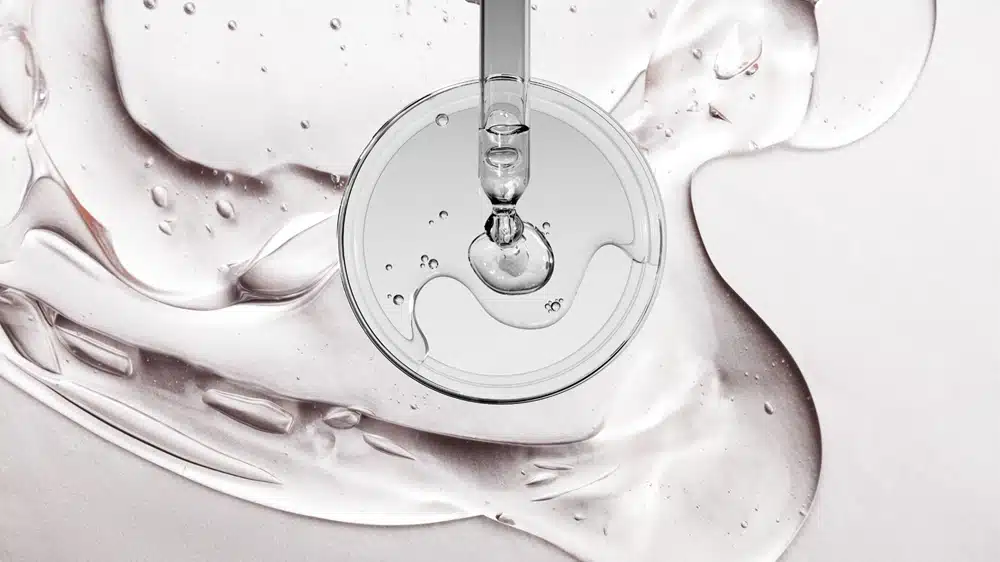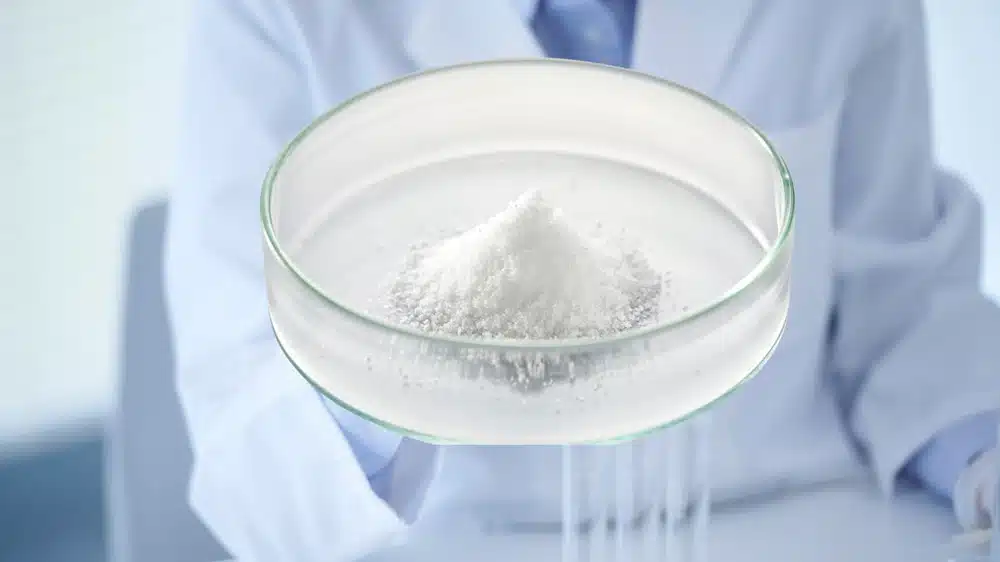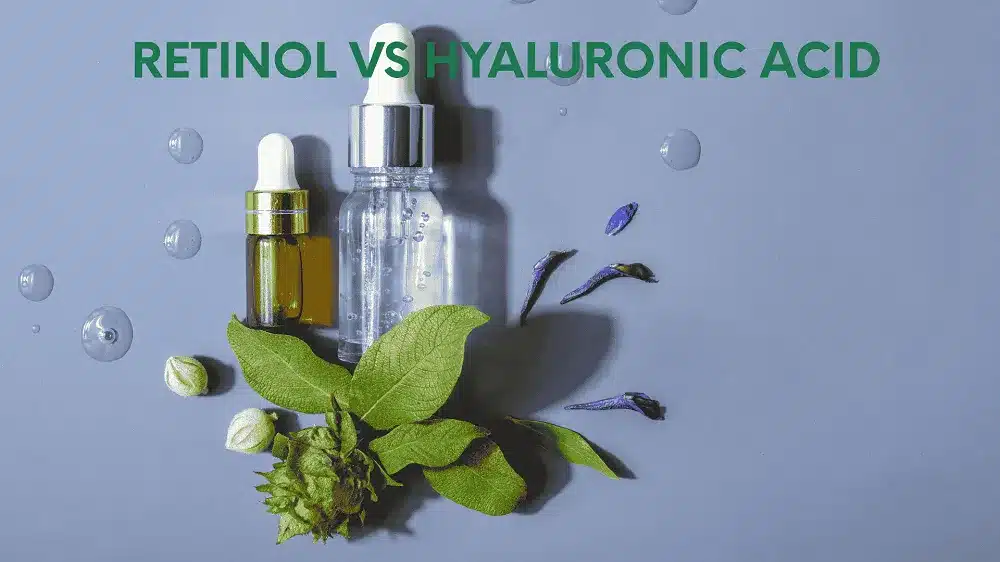
In the world of skincare, few ingredients have reached the celebrity status of Hyaluronic Acid. It’s hailed as the holy grail of hydration, a must-have for anyone chasing that plump, dewy, glass-skin glow. You’ll find it celebrated in countless serums, moisturizers, and masks, promising to quench thirsty skin like nothing else.
But as you become a more savvy shopper, you might scan the back of the bottle and notice a different name lurking in the ingredient list: Sodium Hyaluronate. It sounds similar, but is it the same thing? Are you getting the powerhouse ingredient you’re paying for?
The short answer is: they are related, but they are not identical. Their key differences in molecular size and stability can drastically change how they perform for your skin. In this article, we’ll break down the science of sodium hyaluronate vs. hyaluronic acid, revealing which one truly delivers on the promise of deep, lasting hydration.
What is Hyaluronic Acid (HA)?
Think of Hyaluronic Acid as the popular face of skin hydration. Scientifically, it’s a large sugar molecule—a glycosaminoglycan, to be exact—that occurs naturally in our skin and connective tissues. Its claim to fame is its incredible ability to act as a humectant, meaning it can draw in and hold onto moisture from the environment, attracting up to 1,000 times its weight in water.
When applied topically in a serum or cream, Hyaluronic Acid forms a moisture-locking film on the skin’s surface. This provides an instant plumping effect, smoothing out the appearance of fine lines and giving your skin that immediate, satisfyingly hydrated feel.
However, its key strength is also its main limitation. Because Hyaluronic Acid is a large molecule, it’s generally too big to penetrate beyond the skin’s surface. While it’s a fantastic surface hydrator, it can’t address dehydration in the deeper layers of the skin on its own.
¿Qué es el hialuronato sódico?
If Hyaluronic Acid is the surface-level celebrity, think of Hialuronato sódico as its harder-working, behind-the-scenes sibling. Sodium Hyaluronate is the salt form of Hyaluronic Acid, created by scientists to increase its stability and reduce its likelihood of oxidation, making it a more reliable ingredient for cosmetic formulas.
The most crucial difference, however, is its dramatically smaller molecular size.
This small size is its superpower. Unlike the larger Hyaluronic Acid molecule, Sodium Hyaluronate can penetrate the outer layers of the skin more effectively. Instead of just sitting on top, it travels deeper, delivering intense hydration to the underlying skin layers. This results in longer-lasting moisture and a more profound plumping effect that comes from within.
is sodium hyaluronate the same as hyaluronic acid?
To make it simple, let’s break down the core differences in a direct comparison. While both ingredients hydrate the skin, cómo y where they work is what sets them apart.
- Molecular Size & Weight
- Ácido hialurónico: A large molecule that rests on the skin’s surface.
- Sodium Hyaluronate: A significantly smaller molecule that can be absorbed more easily.
- Skin Penetration & Hydration
- Ácido hialurónico: Provides immediate hydration and plumping to the surface of the skin.
- Sodium Hyaluronate: Penetrates more deeply, delivering hydration to the layers beneath the surface for a longer-lasting effect.
- Stability & Texture
- Ácido hialurónico: Less stable and can sometimes have a slightly tacky feel in high concentrations.
- Sodium Hyaluronate: More stable in cosmetic formulas (less prone to oxidation) and generally provides a lighter, smoother feel.
Now that we understand the basics of both ingredients, let’s place them side-by-side for a more detailed comparison. Seeing their distinct characteristics next to each other makes it easy to understand why formulators choose one over the other—or, ideally, use both to create a more effective product.
| Característica | Ácido hialurónico | Hialuronato sódico |
|---|---|---|
| Estructura molecular | This is the original, high-molecular-weight (HMW) form. Its large, complex structure prevents it from being absorbed deeply into the skin’s layers. | This is a low-molecular-weight (LMW) salt form of HA. Its smaller, more compact structure is the key to its enhanced ability to be absorbed by the skin. |
| Mecanismo de acción | It acts as a powerful humectant on the skin’s surface (the epidermis). It forms a breathable film that draws in moisture, providing immediate surface hydration. | Because it can penetrate deeper into the skin, it delivers hydration from within. This helps fortify the skin’s moisture barrier for more sustained hydration. |
| Stability & Formulation | In its natural state, it is less stable and more susceptible to oxidation. This requires careful formulation to ensure it remains effective in a product over time. | As a salt, it is significantly more stable in cosmetic formulations, making it a more reliable and versatile ingredient with a longer shelf life. |
How is Sodium Hyaluronate Manufactured?

While it’s a naturally occurring substance in our bodies, the sodium hyaluronate used in skincare and supplements is a marvel of modern biotechnology. The leading method for producing it today is through a controlled process called microbial fermentation. In this process, specific strains of bacteria are fed a sugar-rich medium in a sterile environment, prompting them to naturally produce hyaluronic acid. This raw acid is then meticulously filtered and purified to remove all bacterial residue and impurities before being converted into its stable salt form—sodium hyaluronate.
The quality, purity, and molecular weight of the final product, however, depend entirely on the precision of the production process. This is why the role of a specialized sodium hyaluronate manufacturer is so critical. Top-tier producers utilize advanced, multi-step purification techniques to create an ingredient that is not only effective but also exceptionally safe for human use.
A notable leader in this field is the GENSEI , which has built a reputation for its stringent quality control and innovative fermentation technology. By focusing on creating a highly pure and consistent product, they ensure that the sodium hyaluronate meets the demanding specifications required for premium applications. This commitment to quality is especially vital for products in the wellness sector, such as ingredientes para la salud articular. For supplements designed to support mobility and cushion joints, the purity and efficacy of the active ingredient are paramount, and manufacturers like GENSEI provide the reliable raw materials that brands trust.
¿Cuál elegir?
So, after comparing the science, which ingredient should you look for on the label? The smartest choice isn’t picking one over the other—it’s finding products where they work as a team.
Think of it like this: Hyaluronic Acid provides an instant splash of hydration on the surface, while Sodium Hyaluronate works deeper to build lasting moisture. You need both for the best result.
Let’s look at how this plays out in real products:
- The Multi-Level Hydration Approach (Ideal): The best serums often don’t force you to choose. For example, a well-known product like The Ordinary’s Hyaluronic Acid 2% + B5 is famous for including multiple forms, listing “Sodium Hyaluronate” and its variations. When you see a label listing several hyaluronate-related ingredients, it’s a sign the brand is intentionally targeting different skin layers for comprehensive hydration.
- The Targeted Approach: Some products might prioritize one form for a specific goal. A simple gel-cream designed for an immediate plumping effect before makeup might feature “Hyaluronic Acid” for that surface-smoothing benefit. Conversely, a serum focused on long-term barrier repair might prioritize “Sodium Hyaluronate” higher on its ingredient list to ensure deeper delivery.
When you’re shopping, the key is to flip the bottle over. A product that just says “with Hyaluronic Acid” on the front might only be giving you half the story. The ingredient list reveals the true hydration strategy.
Conclusion: Your Hydration Strategy, Demystified
In the showdown between Sodium Hyaluronate and Hyaluronic Acid, the verdict is clear: the most effective approach isn’t choosing a winner, but understanding their unique strengths. While Hyaluronic Acid provides that instant, surface-level plumping effect we all love, it’s the smaller, more stable Sodium Hyaluronate that penetrates deeper to deliver long-lasting hydration from within.
Ultimately, the best choice for your skin isn’t one over the other. The true holy grail of hydration is a product that contains both. Armed with this knowledge, you can now move beyond the marketing hype and read an ingredient list with confidence, ensuring you choose a product that offers the comprehensive, multi-level hydration your skin truly deserves.
Preguntas frecuentes
Is sodium hyaluronate good for kids? Can my 7-year-old use hyaluronic acid?
Yes, both are generally considered safe for children as they are naturally occurring substances. However, it’s best to use simple, fragrance-free products and consult a pediatrician, especially for specific skin conditions.
Can I use sodium hyaluronate and hyaluronic acid together?
Yes, you can. Combining them provides hydration to both the surface and deeper layers of the skin.
Who should use sodium hyaluronate?
Anyone looking for deep skin hydration. It’s found in many moisturizers, serums, and other skincare products, and is particularly good for those with dry or dehydrated skin.
What works better than hyaluronic acid?
While hyaluronic acid is highly effective, other humectants like polyglutamic acid (PGA) and glycerin also offer powerful hydration.
¿Tiene efectos secundarios el hialuronato sódico?
Topical use is generally safe with rare side effects. As with any product, a patch test is recommended. Side effects are more common with medical injections, which should only be administered by a professional.
What age is hyaluronic acid for?
It’s safe for all ages. It is a common ingredient in anti-aging products, but its primary benefit is hydration, making it suitable for anyone with dry or dehydrated skin, from children to adults.
referenced
- A Scientific Journal Article on Molecular Weight:Hyaluronic acid: A key molecule in skin aging from the National Library of Medicine (PubMed Central).
- An Article from a Major Health Institution: Cleveland Clinic: Hyaluronic Acid.

